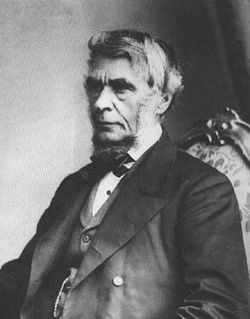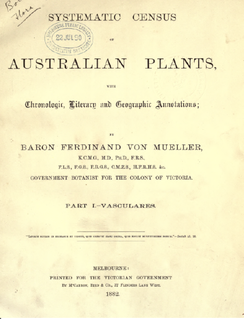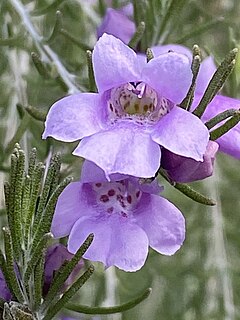
George Bentham was an English botanist, described by the weed botanist Duane Isely as "the premier systematic botanist of the nineteenth century". Born into a distinguished family, he initially studied law, but had a fascination with botany from an early age, which he soon pursued, becoming president of the Linnaean Society in 1861, and a fellow of the Royal Society in 1862. He was the author of a number of important botanical works, particularly flora. He is best known for his taxonomic classification of plants in collaboration with Joseph Dalton Hooker, his Genera Plantarum (1862–1883). He died in London in 1884.

Bosistoa is a genus of four species of tree in the family Rutaceae endemic to eastern Australia. They have simple or compound leaves arranged in opposite pairs and bisexual flowers arranged in panicles, each flower with five sepals, five white petals and ten stamens.

Flora of Australia is a 59 volume series describing the vascular plants, bryophytes and lichens present in Australia and its external territories. The series is published by the Australian Biological Resources Study who estimate that the series when complete will describe over 20 000 plant species. It was orchestrated by Alison McCusker.
Banksia densa is a species of column-like shrub that is endemic to Western Australia. It has deeply serrated to pinnatifid leaves, creamy yellow flowers in heads of up to seventy-five, and hairy follicles.

Banksia splendida, commonly known as shaggy dryandra, is a species of shrub that is endemic to the southwest of Western Australia. It has sharply-pointed linear leaves that are woolly on the lower surface, cream-coloured and maroon or yellow flowers in heads of between 65 and 115, and later up to eight egg-shaped follicles in each head.
Banksia tortifolia is a small, spreading, prostrate shrub that is endemic to the southwest of Western Australia. It has short underground stems, pinnatipartite leaves with sharply-pointed, linear lobes on each side, greenish-cream, yellow and pink flowers in heads of about eighty, and glabrous, egg-shaped follicles.

Banksia armata var. armata is a variety of shrub that is endemic to Western Australia. It differs from the other variety in having a lignotuber, narrower leaves with more sides lobes and shorter flowers. It is also usually a shorter plant.

The Systematic census of Australian plants, with chronologic, literary and geographic annotations, more commonly known as the Systematic Census of Australian Plants, also known by its standard botanic abbreviation Syst. Census Austral. Pl., is a survey of the vascular flora of Australia prepared by Government botanist for the state of Victoria Ferdinand von Mueller and published in 1882.

Acacia schinoides is a shrub or tree indigenous to Australia. It has also been introduced into Kenya and Zimbabwe and it is cultivated there. A common name for the plant in Australia is green cedar wattle.
George Maxwell (1804–1880) was a professional collector of plants and insects in Southwest Australia. The botanical specimens he obtained were used to make formal descriptions of the region's plant species.

The flora of Western Australia comprises 10,252 published native vascular plant species and a further 1,245 unpublished species. They occur within 1,543 genera from 211 families; there are also 1,276 naturalised alien or invasive plant species more commonly known as weeds. There are an estimated 150,000 cryptogam species or nonvascular plants which include lichens, and fungi although only 1,786 species have been published, with 948 algae and 672 lichen the majority.

Pentaceras australe, commonly known as bastard crow's ash, penta ash or black teak, is the only species in the genus Pentaceras in the plant family Rutaceae. It is a small to medium-sized rainforest tree endemic to eastern Australia. It has pinnate leaves with up to fifteen leaflets, small white flowers arranged in panicles on the ends of branchlets, and winged seeds.

Adenanthos macropodianus, commonly known as gland flower, or Kangaroo Island gland flower, is a species of shrub in the family Proteaceae. It is endemic to Kangaroo Island in South Australia. First published as a variety of A. sericeus in 1870, it was promoted to species rank in 1978.

Adenanthos sect. Eurylaema is a taxonomic section of the flowering plant genus Adenanthos (Proteaceae). It comprises four species, all of which are endemic to southwest Western Australia.

Eremophila microtheca, also known as heath-like eremophila, is a flowering plant in the figwort family, Scrophulariaceae and is endemic to Western Australia. It is an erect shrub with densely hairy branches and leaves, narrow leaves and pale lilac-coloured flowers and which emits a strong odour.
Calytrix achaeta, commonly known as the white-flowered turkey bush, kerosene wood or fringe-myrtle, is a species of plant in the myrtle family Myrtaceae that is endemic to Western Australia.

Liparis habenarina, commonly known as the common sphinx orchid or common hobgoblin orchid, is a plant in the orchid family and is endemic to Australia. It is a deciduous, terrestrial orchid with two or three egg-shaped leaves and between eight and twenty-two brownish to purplish flowers with their lateral sepals joined at the base. It grows in the understorey of near-coastal forests.
Liparis coelogynoides, commonly known as the fairy sphinx orchid, is a plant in the orchid family and is endemic to near-coastal eastern Australia. It is an epiphytic orchid with two leaves joined at the base and that grows in clumps. Greenish white or yellowish flowers are borne on an often hanging spike. It grows on trees and cliff faces usually on ranges near the coast of northern New South Wales and southern Queensland.

Eulophia venosa, commonly known as the pointed corduroy orchid, is a plant in the orchid family and is native to India, parts of Southeast Asia as well as New Guinea and northern Australia. It is a deciduous, terrestrial orchid with one large and one small leaf and between six and twenty pale green or yellowish flowers with purple markings. It grows in rainforest and grassy forests.

Asterolasia grandiflora is a species of weak, open shrub or sub-shrub that is endemic to the southwest of Western Australia. It has oblong, elliptical or egg-shaped leaves and pink to mauve flowers arranged in umbels of about three flowers with a thick covering of star-shaped hairs on the back of the petals.















